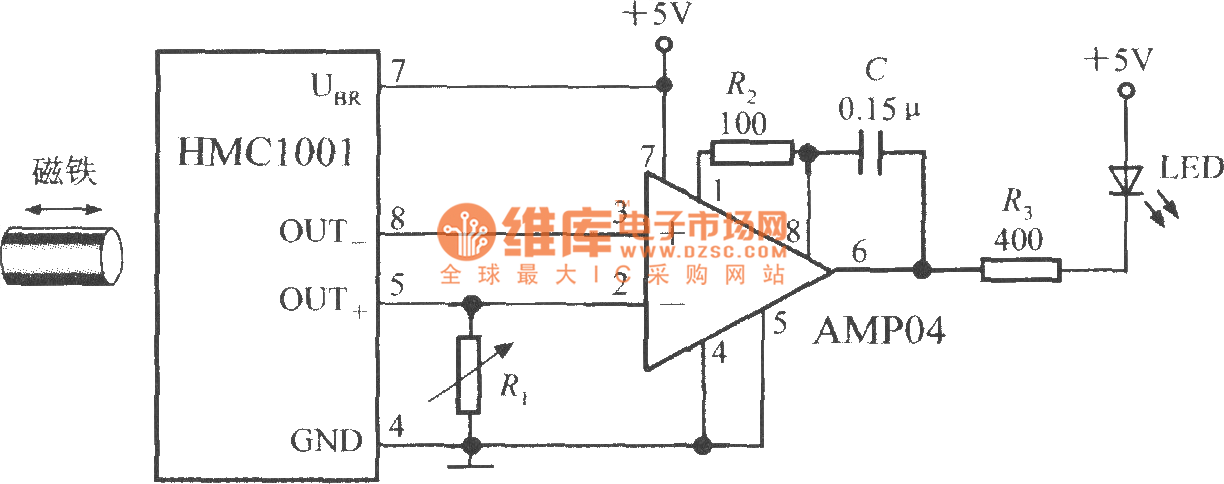
LED fast optical pulse generating circuit diagram

The entire series of TTL monostable multivibrators lacks sufficient speed, prompting the need for an ECL voltage swing that accommodates a wide range of small power requirements. This necessitates the use of F series circuits, which offer fast transition times and minimal transmission delays. Consequently, a compact and portable fast optical pulse generator is developed for high-speed photomultiplier applications in gamma-ray astronomy research. The design incorporates only two integrated circuits, which effectively reduces size and power consumption. The output from gate G4 in IC2 produces pulses with a normal high of approximately 2.5 ns rise and fall times, and a pulse width of less than 10 ns, corresponding to three gate delays. These pulses are well-suited for the low cathode potential of the HLMP-CB-15 high-speed blue LED, with the anode of the LED clamped to 5V. G4 ensures that nearly the entire 5V supply voltage is applied to the LED, resulting in a significant voltage swing that optimizes the brightness of the LED at the insulation displacement connector located at the edge of a compact printed circuit board. Additionally, a rechargeable battery is mounted on the opposite side of the printed circuit board. The circuit employs a CMOS timer IC1, which operates at a current consumption of less than 4 mA.
The described circuit functions as a high-speed optical pulse generator, designed to meet the demands of photomultiplier applications in gamma-ray astronomy. The use of F series circuits is critical due to their ability to provide rapid transition times and low propagation delays, which are essential for generating fast optical pulses.
The integration of only two ICs minimizes the overall footprint of the circuit, making it suitable for portable applications. The specific choice of the HLMP-CB-15 LED is significant, as its low cathode potential allows for efficient operation within the circuit's constraints. The output characteristics of gate G4 are particularly important, as the rapid rise and fall times ensure that the generated pulses can be effectively utilized in high-speed applications.
The circuit's design includes a clamping mechanism for the LED anode, ensuring that it operates at an optimal voltage of 5V, which maximizes brightness and efficiency. The inclusion of a rechargeable battery enhances the circuit's portability and sustainability, allowing it to function effectively in field tests without the need for constant external power sources. The low current consumption of the CMOS timer IC1 further contributes to the circuit's efficiency, making it suitable for prolonged use in research settings.
Overall, this compact optical pulse generator is a vital tool for advancing research in gamma-ray astronomy, providing the necessary speed and efficiency to facilitate high-quality data collection in this field.Due to the lack of speed in the entire series TTL monostable multivibrator, and because of the requirements of ECL voltage swing wide range of small and power, which drives us to use F series circuit having a fast transition time and the small transmission delay. This creates a compact portable fast optical pulse generator for high-speed photomultiplier used in gamma-ray astronomy research conducted field tests. Use only two integrated circuit helps reduce size and power consumption (Figure 1). The output of gate G4 in the IC2 output pulse having a normal high of about 2.5ns rise and fall time and pulse width of less than 10 ns, which is equivalent to three gate delays.
These pulses are very suitable for low cathode potential HLMP-CB-15 high-speed blue LED, and the LED anode is clamped to 5V. G4 forcing almost the entire 5 V supply voltage is applied to the LED, such a large voltage swing can be sure that the insulation displacement connector at the edge of a small printed circuit board with the best LED brightness.
Rechargeable battery fixed to the printed circuit board on the other side. The circuit uses CMOS timer IC1, consumes less than 4 mA current. alt="LED fast optical pulse generating circuit diagram">
The described circuit functions as a high-speed optical pulse generator, designed to meet the demands of photomultiplier applications in gamma-ray astronomy. The use of F series circuits is critical due to their ability to provide rapid transition times and low propagation delays, which are essential for generating fast optical pulses.
The integration of only two ICs minimizes the overall footprint of the circuit, making it suitable for portable applications. The specific choice of the HLMP-CB-15 LED is significant, as its low cathode potential allows for efficient operation within the circuit's constraints. The output characteristics of gate G4 are particularly important, as the rapid rise and fall times ensure that the generated pulses can be effectively utilized in high-speed applications.
The circuit's design includes a clamping mechanism for the LED anode, ensuring that it operates at an optimal voltage of 5V, which maximizes brightness and efficiency. The inclusion of a rechargeable battery enhances the circuit's portability and sustainability, allowing it to function effectively in field tests without the need for constant external power sources. The low current consumption of the CMOS timer IC1 further contributes to the circuit's efficiency, making it suitable for prolonged use in research settings.
Overall, this compact optical pulse generator is a vital tool for advancing research in gamma-ray astronomy, providing the necessary speed and efficiency to facilitate high-quality data collection in this field.Due to the lack of speed in the entire series TTL monostable multivibrator, and because of the requirements of ECL voltage swing wide range of small and power, which drives us to use F series circuit having a fast transition time and the small transmission delay. This creates a compact portable fast optical pulse generator for high-speed photomultiplier used in gamma-ray astronomy research conducted field tests. Use only two integrated circuit helps reduce size and power consumption (Figure 1). The output of gate G4 in the IC2 output pulse having a normal high of about 2.5ns rise and fall time and pulse width of less than 10 ns, which is equivalent to three gate delays.
These pulses are very suitable for low cathode potential HLMP-CB-15 high-speed blue LED, and the LED anode is clamped to 5V. G4 forcing almost the entire 5 V supply voltage is applied to the LED, such a large voltage swing can be sure that the insulation displacement connector at the edge of a small printed circuit board with the best LED brightness.
Rechargeable battery fixed to the printed circuit board on the other side. The circuit uses CMOS timer IC1, consumes less than 4 mA current. alt="LED fast optical pulse generating circuit diagram">





